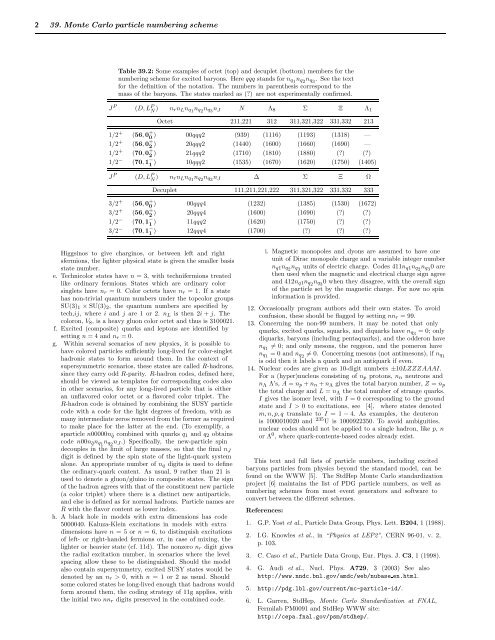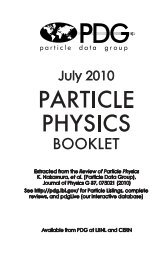39. monte carlo particle numbering scheme - Particle Data Group
39. monte carlo particle numbering scheme - Particle Data Group
39. monte carlo particle numbering scheme - Particle Data Group
Create successful ePaper yourself
Turn your PDF publications into a flip-book with our unique Google optimized e-Paper software.
2 <strong>39.</strong> Monte Carlo <strong>particle</strong> <strong>numbering</strong> <strong>scheme</strong><br />
Table <strong>39.</strong>2: Some examples of octet (top) and decuplet (bottom) members for the<br />
<strong>numbering</strong> <strong>scheme</strong> for excited baryons. Here qqq stands for nq 1 nq 2 nq 3 . See the text<br />
for the definition of the notation. The numbers in parenthesis correspond to the<br />
mass of the baryons. The states marked as (?) are not experimentally confirmed.<br />
J P (D, L P N ) nrn Lnq 1 nq 2 nq 3 n J N Λ8 Σ Ξ Λ1<br />
Octet 211,221 312 311,321,322 331,332 213<br />
1/2 + (56,0 + 0 ) 00qqq2 (939) (1116) (1193) (1318) —<br />
1/2 + (56,0 + 2 ) 20qqq2 (1440) (1600) (1660) (1690) —<br />
1/2 + (70,0 + 2 ) 21qqq2 (1710) (1810) (1880) (?) (?)<br />
1/2− (70,1 − 1 ) 10qqq2 (1535) (1670) (1620) (1750) (1405)<br />
J P (D, L P N ) nrn Lnq 1 nq 2 nq 3 n J ∆ Σ Ξ Ω<br />
Decuplet 111,211,221,222 311,321,322 331,332 333<br />
3/2 + (56,0 + 0 ) 00qqq4 (1232) (1385) (1530) (1672)<br />
3/2 + (56,0 + 2 ) 20qqq4 (1600) (1690) (?) (?)<br />
1/2− (70,1 − 1 ) 11qqq2 (1620) (1750) (?) (?)<br />
3/2− (70,1 − 1 ) 12qqq4 (1700) (?) (?) (?)<br />
Higgsinos to give charginos, or between left and right<br />
sfermions, the lighter physical state is given the smaller basis<br />
state number.<br />
e. Technicolor states have n = 3, with technifermions treated<br />
like ordinary fermions. States which are ordinary color<br />
singlets have nr = 0. Color octets have nr = 1. If a state<br />
has non-trivial quantum numbers under the topcolor groups<br />
SU(3)1 × SU(3)2, the quantum numbers are specified by<br />
tech,ij, where i and j are 1 or 2. n L is then 2i + j. The<br />
coloron, V8, is a heavy gluon color octet and thus is 3100021.<br />
f. Excited (composite) quarks and leptons are identified by<br />
setting n = 4 and nr = 0.<br />
g. Within several scenarios of new physics, it is possible to<br />
have colored <strong>particle</strong>s sufficiently long-lived for color-singlet<br />
hadronic states to form around them. In the context of<br />
supersymmetric scenarios, these states are called R-hadrons,<br />
since they carry odd R-parity. R-hadron codes, defined here,<br />
should be viewed as templates for corresponding codes also<br />
in other scenarios, for any long-lived <strong>particle</strong> that is either<br />
an unflavored color octet or a flavored color triplet. The<br />
R-hadron code is obtained by combining the SUSY <strong>particle</strong><br />
code with a code for the light degrees of freedom, with as<br />
many intermediate zeros removed from the former as required<br />
to make place for the latter at the end. (To exemplify, a<br />
s<strong>particle</strong> n00000n˜q combined with quarks q1 and q2 obtains<br />
code n00n˜qnq 1 nq 2 nJ.) Specifically, the new-<strong>particle</strong> spin<br />
decouples in the limit of large masses, so that the final n J<br />
digit is defined by the spin state of the light-quark system<br />
alone. An appropriate number of nq digits is used to define<br />
the ordinary-quark content. As usual, 9 rather than 21 is<br />
used to denote a gluon/gluino in composite states. The sign<br />
of the hadron agrees with that of the constituent new <strong>particle</strong><br />
(a color triplet) where there is a distinct new anti<strong>particle</strong>,<br />
and else is defined as for normal hadrons. <strong>Particle</strong> names are<br />
R with the flavor content as lower index.<br />
h. A black hole in models with extra dimensions has code<br />
5000040. Kaluza-Klein excitations in models with extra<br />
dimensions have n = 5 or n = 6, to distinquish excitations<br />
of left- or right-handed fermions or, in case of mixing, the<br />
lighter or heavier state (cf. 11d). The nonzero nr digit gives<br />
the radial excitation number, in scenarios where the level<br />
spacing allow these to be distinguished. Should the model<br />
also contain supersymmetry, excited SUSY states would be<br />
denoted by an nr > 0, with n = 1 or 2 as usual. Should<br />
some colored states be long-lived enough that hadrons would<br />
form around them, the coding strategy of 11g applies, with<br />
the initial two nnr digits preserved in the combined code.<br />
i. Magnetic monopoles and dyons are assumed to have one<br />
unit of Dirac monopole charge and a variable integer number<br />
nq1nq 2 nq 3 units of electric charge. Codes 411nq1nq 2 nq 3 0 are<br />
then used when the magnetic and electrical charge sign agree<br />
and 412nq1nq 2 nq 3 0 when they disagree, with the overall sign<br />
of the <strong>particle</strong> set by the magnetic charge. For now no spin<br />
information is provided.<br />
12. Occasionally program authors add their own states. To avoid<br />
confusion, these should be flagged by setting nnr = 99.<br />
13. Concerning the non-99 numbers, it may be noted that only<br />
quarks, excited quarks, squarks, and diquarks have nq 3 = 0; only<br />
diquarks, baryons (including pentaquarks), and the odderon have<br />
nq 1 = 0; and only mesons, the reggeon, and the pomeron have<br />
nq 1 = 0 and nq 2 = 0. Concerning mesons (not antimesons), if nq 1<br />
is odd then it labels a quark and an antiquark if even.<br />
14. Nuclear codes are given as 10-digit numbers ±10LZZZAAAI.<br />
For a (hyper)nucleus consisting of np protons, nn neutrons and<br />
n Λ Λ’s, A = np + nn + n Λ gives the total baryon number, Z = np<br />
the total charge and L = nΛ the total number of strange quarks.<br />
I gives the isomer level, with I = 0 corresponding to the ground<br />
state and I > 0 to excitations, see [4], where states denoted<br />
m, n, p, q translate to I = 1 − 4. As examples, the deuteron<br />
is 1000010020 and 235 U is 1000922350. To avoid ambiguities,<br />
nuclear codes should not be applied to a single hadron, like p, n<br />
or Λ 0 , where quark-contents-based codes already exist.<br />
This text and full lists of <strong>particle</strong> numbers, including excited<br />
baryons <strong>particle</strong>s from physics beyond the standard model, can be<br />
found on the WWW [5]. The StdHep Monte Carlo standardization<br />
project [6] maintains the list of PDG <strong>particle</strong> numbers, as well as<br />
<strong>numbering</strong> <strong>scheme</strong>s from most event generators and software to<br />
convert between the different <strong>scheme</strong>s.<br />
References:<br />
1. G.P. Yost et al., <strong>Particle</strong> <strong>Data</strong> <strong>Group</strong>, Phys. Lett. B204, 1 (1988).<br />
2. I.G. Knowles et al., in “Physics at LEP2”, CERN 96-01, v. 2,<br />
p. 103.<br />
3. C. Caso et al., <strong>Particle</strong> <strong>Data</strong> <strong>Group</strong>, Eur. Phys. J. C3, 1 (1998).<br />
4. G. Audi et al., Nucl. Phys. A729, 3 (2003) See also<br />
http://www.nndc.bnl.gov/amdc/web/nubase en.html.<br />
5. http://pdg.lbl.gov/current/mc-<strong>particle</strong>-id/.<br />
6. L. Garren, StdHep, Monte Carlo Standardization at FNAL,<br />
Fermilab PM0091 and StdHep WWW site:<br />
http://cepa.fnal.gov/psm/stdhep/.







